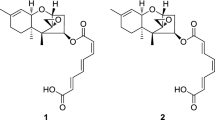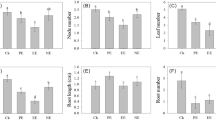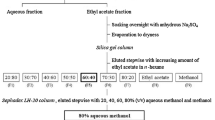Abstract
The allelopathic weed Russian knapweed (Centaurea repens) was found to contain polyacetylenes VIII–XIV in the roots. Dose vs. response of the root length elongation against lettuce, alfalfa, barnyard grass, and red millet showed IX to be active. Closely related isomers were not active. Examination of the soil surrounding the Russian knapweed roots revealed the presence of IX in sufficient concentration to have an appreciable effect on the surrounding plant community.
Similar content being viewed by others
References
Bohlmann, F., Arndt, C., Kleine, K.-M., andBornowski, H. 1965. Die Acetylenverbindungen der GattungEchinops L.Chem. Ber. 98:155–163.
Bohlmann, F., Rode, K.-M., andZdero, C. 1966. Neue Polyine der GattungCentaurea L.Chem. Ber. 99:3544–3551.
Bohlmann, F., Burkhart, T., andZdero, C. 1973. Naturally Occurring Acetylenes. Academic Press, New York.
Campbell, G., Lambert, J.D.H., Arnason, T., andTowers, G.H.N. 1982. Allelopathic Properties of α-terthienyl and phenylheptatriyne, naturally occurring compounds from species of Asteraceae.J. Chem. Ecol. 8:961–972.
Fletcher, R.A., andRenney, A.J. 1963. A growth inhibitor found inCentaurea spp.Can. J. Plant Sci. 43:475–481.
Ichihara, K., Kawai, T., Masayuki, K., andNoda, M. 1976. A New Polyacetylene fromSolidago altissima L.Agric. Biol. Chem. 40:353–358.
Ichihara, K., Kawai, T.; andNoda, M. 1978. Polyacetylenes ofSolidago altissima L.Agric. Biol. Chem. 42:427–431.
Kawazu, K.,Nakamura, A.,Nishino, S.,Koshimizu, H., andMitsui, T. 1969. Plant growth regulator inSolidago altissima. Annual Meeting of Agricultural Chemical Society of Japan. Abstract, p. 130.
Kobayashi, A., Morimoto, S., andShibata, Y. 1974. Allelopathic substances in Compositae family.Chem. Regul. Plant. 9:95–100.
Kobayashi, A., Morimoto, S., Shibata, Y., Yamashita, K., andNumata, M. 1980. C10 polyacetylenes as allelopathic substances in dominants in early stages of secondary succession.J. Chem. Ecol. 6:119–131.
Numata, N.,Kobayashi, A., andOhga, N. 1973. Studies on allelopathic substances concerning the formation of the urban flora, pp. 59–64,in M. Numata (ed.). Fundamental Studies in the Characteristics of Urban Ecosystems.
Stevens, K.L. 1982. Sesquiterpene lactones FromCentaurea repens.Phytochemistry 21:1093–1098.
Stevens, K.L., andMerrill, G.B. 1985. Sesquiterpene lactones and allelochemicals fromCentaurea species, pp. 83–98,in A.C. Thompson (ed.). The Chemistry Of Allelopathy. A.C.S. Symposium Series 268. American Chemical Society, Washington, D.C.
Author information
Authors and Affiliations
Rights and permissions
About this article
Cite this article
Stevens, K.L. Allelopathic polyacetylenes fromCentaurea repens (Russian knapweed). J Chem Ecol 12, 1205–1211 (1986). https://doi.org/10.1007/BF01012342
Received:
Accepted:
Issue Date:
DOI: https://doi.org/10.1007/BF01012342




